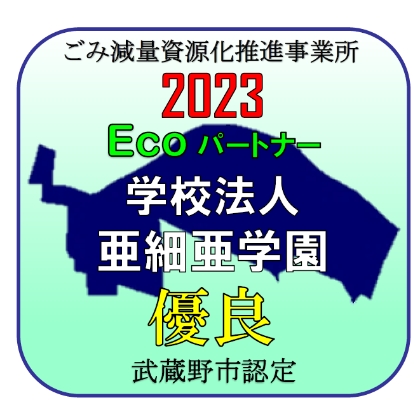- Asia University
- About Asia University
- Efforts of Asia University
- Environmental Initiatives
Environmental Initiatives
PAGE SECTIONS
Asia Gakuen is working on environmental problem countermeasures from both hardware and software aspects.
As an educational business, what can we do for Asia, the world, and the earth?Under the motto, "There is ecology in learning," students, faculty and staff think and take action.
Environmental measures using equipment (hardware)
Ingenuity of energy saving
Active use of natural light
Buildings No. 1, No. 2, No. 5, and ASIA PLAZA take in a lot of natural light from the windows and use efficient lighting to enhance the lighting environment and save power consumption. In other buildings as well, when the classroom lighting was renewed, we switched to energy-saving lighting fixtures (including emergency lighting) in an effort to conserve energy.Lighting control with motion sensor
The lighting in the classrooms is controlled by motion sensors and the illuminance is adjusted in consideration of outside light.The lights in the restrooms and corridors are also turned on and off by motion sensors, so there is no need to leave the lights on.
Introduced LED lights
LED lights have been installed for all lighting in Buildings 1, 5, ASIA PLAZA, Kozo Ota Memorial Hall, Asia Hall 2, and Gymnasium floor.Efficient classroom air-conditioning management
Classroom air conditioning is controlled so that it is turned off at the end of class. This prevents unnecessary use of air conditioning in unused classrooms.Efficient heating and cooling with double glazing
When renovating heating and cooling equipment, we replace it with more efficient equipment. In addition, we are working to save energy by using double-layered glass windows and applying heat-reflecting film.harmony with nature
Efficient reuse of rainwater
Buildings 1, 2, 5 and ASIA PLAZA collect rainwater in underground water tanks and use it to flush toilets and water the plants on the rooftop garden of Building 2.About 3.5 tons of rainwater is reused annually, depending on the amount of rainfall in that year.
Making Sengawa Hydrophilic and Making it a Healing Space
The Sen River flows between Building No. 2 and Student Association Building. It used to be covered with concrete slopes, but in the spring of 2006, it was renovated and transformed into a comfortable space. A biotope is a space in a city where animals and plants can live. In addition to rainwater, the flowing water is conveyed from the Sakai Water Purification Plant. Crayfish, killifish, and spot-billed ducks keep you cool even on hot summer days, making you feel at ease in this healing space.Rooftop greening as a countermeasure against global warming
Building No. 2 has a rooftop garden on the 3rd and 5th floors to curb global warming. The trees that were felled when building Building No. 2 were revived as tables and benches, providing a space for students to relax. The garden has seasonal flowers such as hanakaidou and azaleas, and when the weather is fine, you can enjoy the view of the sub-center of Shinjuku from the 5th floor.Photovoltaic system on the roof
A solar power generation system is installed on the roof of Building 7. The system is expected to generate approximately 40,000 kWh of power per year, which will be used for lighting and other electrical equipment in Building No. 7. In front of the entrance on the 1st floor of Building No. 7, there is a monitor that displays the "current power generation", "today's power generation", "current sun intensity", and "current temperature".Adoption of natural ventilation system
Building No. 1 has a natural ventilation system (gravity ventilation) using the staircase, and a natural ventilation transom between Research Office and the corridor.Building No. 5 employs a ventilation and control system that provides natural ventilation according to weather conditions.
When the windows of each classroom are opened, a pleasant natural breeze flows from the corridor through the atrium and through the ventilation windows of the skylights that open and close automatically. It is an eco-friendly system that uses less power and uses the power of nature (gravity ventilation) with less thermal environmental impact.
Adjust light and heat with the light shelf
Building No. 5 has an eave called a "light shelf" on the window of the south-facing classroom. By reducing the amount of direct sunlight, the thermal environment in the classroom is controlled. This is an energy-saving technology that passively adjusts the light and heat environment in the classroom in a well-balanced manner, not only blocking light but also brightening up the ceiling with gentle reflected light that bounces off the upper surface of the eaves.Environmental measures by human power (soft side)
the spirit of Self-help and Cooperation eco activities
Summer Energy Saving Measures and Cool Biz

In addition to promoting the “Cool Biz” campaign, which calls for no necktie and no outerwear, with air conditioners set at 28°C, we are focusing on the following items.
1. Let's try to adjust the room temperature during cooling with a guideline of 28℃.
2.Do not leave the air conditioner on unnecessarily.
2. Power supply for lighting and fixtures
1.Turn off the lights in classrooms, offices, Research Office, etc. that are not in use.
2.Do not leave OA equipment with the power on for a long time.
3. Unplug electrical appliances that are not used for a long time.
3. Cooling period
Due to temperature fluctuations, there are differences in the cooling period, but the guideline for the cooling period is as follows.
Cooling period: Mid-June to late September
4. As part of efforts to conserve energy and resources, Administrative Offices implemented a no-tie, no-jacket campaign.
*Asia Gakuen has registered to support the "Fun to share" climate change campaign.
Energy-saving measures in winter and Warm Biz

We encourage our faculty and staff members to practice Warm Biz, focusing on the following items.
1. Let's try to adjust the room temperature appropriately so that it does not become excessive with a guideline of 20 degrees Celsius during heating.
2.Be sure to wear appropriate clothing so that you can feel comfortable in the office and Research Office.
2. Power supply for lighting and fixtures
1.Turn off the lights in classrooms, offices, Research Office, etc. that are not in use.
2. Do not leave OA equipment with the power turned on for a long time.
3.Do not use stoves while heating.
4.In addition, when not using electrical products, be sure to unplug them from the outlet.
3. Heating period
Due to temperature fluctuations, the heating period varies, but the approximate heating period is as follows.
Heating period: mid-November to late March
*Asia Gakuen has registered to support the "Fun to share" climate change campaign.
Curriculum related to the environment (establishment of Subject)
Environmental science (Subject Open to All students), Environmental economics (economics/specialized subject), Introduction to global environmental issues (international relations/specialized subject), Environment and development (international relations/specialized subject), Learning about the global environment through experience (multicultural Communication/Specialized Subjects) have been established to provide educational and research content related to ecology. In addition, there are many eco-related research presentations and field surveys by student groups.Garbage pick-up activity by student groups
Members of the student body regularly take turns in campaigning for ethical beautification. In addition to striving to beautify the school grounds and commuting routes, we are also active in separating garbage. In addition, staff volunteers are also involved in activities such as picking up trash in the Tama River area.Eco activities at each event
At the school festival ""ASIA-SAI" Annual Student Festival", we are trying to operate eco-friendly events such as separating garbage, encouraging the use of tent stalls, and prohibiting the use of cars. In addition, self-help eco-activities are active, such as the participation of Exploration Club in a long-distance relay race while picking up trash along the road.Certified as a Musashino city garbage reduction and recycling promotion company (Eco partner)

In addition to striving to reduce the generation of garbage and thoroughly sort garbage, the university is taking measures such as implementing the recycling of raw garbage discharged from the campus. In addition, the students' awareness of environmental issues was high, and they were highly evaluated for their active participation in environmental events.
● Efforts to sort waste
In order to prevent waste plastics and miscellaneous paper from being mixed with combustible waste, students, faculty and staff work together to check the sorting at the waste storage area.
●Recycling status
We have implemented recycling of all raw garbage, and have installed many recycling boxes for used paper such as newspapers, magazines and standard paper in the facility, and are recycling all reusable items.
●Environmental action
- We have adopted paperless meetings and online meetings as an initiative to reduce waste generation.
- Through the digitization of handouts accompanying the implementation of online classes, efforts are being made to reduce the amount of waste paper in general.
- Students and faculty members are working with an awareness of garbage separation and resource reduction.
Climate change campaign "Fun to Share"

Asia Gakuen has registered to support the efforts of the climate change campaign "Fun to share".
<Updated on February 20, 2024>